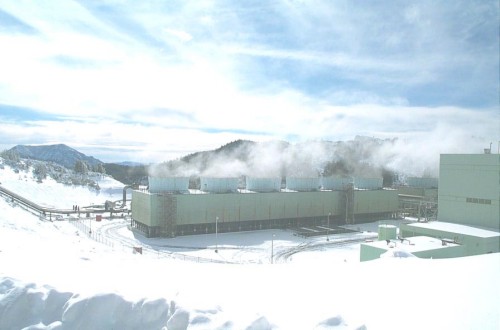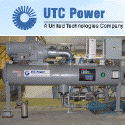Archive for the 'Business' Category
Raser acquires yet another lease
Raser Technologies has been in the news alot lately. Today they’ve announced another 4,000+ acres of leased land in central Utah. One has to wonder if the press release strategy will cause a backlash as the timeline and costs for development become clear to investors.
Comments are off for this post
While waiting for Calpine’s announcement

You might want to take the time to review their recently filed annual report. There is a treasure trove of information disclosed in this document about Calpine and its 273 subsidiary companies. It’s clear that Calpine is endeavoring to position itself as a “clean energy provider” and the crown jewel of that effort is the Geysers geothermal plant portfolio.
The Geysers has been under development since the early 1960s, it’s an active seismic area about 75 miles north-northeast of San Francisco that produces hot, dry steam, a reasonably rare geothermal resource (there are 5 such fields in production globally.) The 1980’s saw massive expansion in the area and production peaked at around 2250MW in 1989, but there was a problem. Steam pressure was dropping quickly and no one seemed to know what to do about it.
The basic problem was over production coupled with exhausting the geothermal resource into the atmosphere. The Geysers plants in general, have production wells that route the steam to turbines attached to generators. After the steam is “used”, it is routed to a condenser and then to a cooling tower where 70% of the mass is emitted into the atmosphere and about 30% returns to liquid state. Along the way, non-condensable gases are removed (like Sulphur, Mercury, and Vanandium) to eliminate atmospheric pollution.
Since the 1990’s, the 30% condensed liquid has been injected back into the reservoir which helped slow the decline in steam pressure. In the late-1990’s, two pipelines were constructed from Clearlake and Santa Rosa pump around 19 million gallons per day of treated wastewater (grey water – aptly named “flush to flash”) to the field for injection into the reservoir. This has served to stabilize the reservoir at around 900MW gross output, with slight declines still seen year over year.
Calpine acquired 20 of the 22 operating plants from PG&E in 1999 for a reported bargain price of $155M. As of the information in the most recent report, the 19 operating plants (1 remains offline) produced 6.6 million megawatt hours in 2006, at market prices of $70 per megawatt hour, around $462 million dollars worth of power from a reported 725MW portfolio. The numbers don’t quite add up as that would put the the capacity factor of the 725MW at 105% vs. the 90-95% that is common for geothermal operators. (Note: The other two plants at the Geysers are owned and operated by the Northern California Power Association currently producing some 132MW gross, 120MW net. And it’s interesting to note that US Renewables is reviving the Bottlerock plant and Western GeoPower is riviving PG&E’s old Unit 15 plant.)
While the geothermal portion of the Calpine portfolio performed well, it’s clear that the natural gas segment is sagging. Between interest charges and fuel expense, it’s a money losing operation. Fuel costs increased to 48.3% of revenue in 2006 from 45.7% in 2005 (it is true that absolute fuel cost decreased to $3.2B in 2006 vs $4.6B in the same period, divestiture of non-performing plants has helped.) Interest expense increased to 18.8% of revenue from 13.8% the prior year (absolute value again decreased to $1.2B from $1.4B.)
As Calpine is snagged up, I have to wonder what the purchaser will do with the Geysers asset. It’s clear that the unit would be profitable on its own. Perhaps a spin out?
Court ruling changes economics
From Renewable Energy Access:
Comments are off for this postIn simple terms, the Court rejected arguments by many electric utilities whose power plants were grandfathered into the Clean Air Act, and then maintained that if they upgraded these power plants — they still would not have to meet Clean Air Act standards.
Renewable energy experts hailed the ruling as the first step to force baseload coal plants to invest in meeting emissions standards like all other energy sources — and that these investments will be reflected in increased rates, making baseload renewables such as biopower, concentrated solar, geothermal and wind more competitive.
UTC scores a big deal

280kw (225kw net) PureCycle Unit
In what must be the largest deal yet for the UTC PureCycle binary power unit, Raser Technologies has placed an order for 135 units for use in its developing projects.
Effectively, UTC is using its experience in the industrial chiller field to run the chiller backwards using the geothermal resource as input. What distinguishes the UTC approach from others is two fold: operating temperature range 74C (165F) to 150C (300F) and modularity. The units are designed to work individually or to be ganged up in pods as large as 40 units with 9MW net output. It’s really a nice product and Raser shows good business sense by heading this direction. And, it’s a really nice endorsement of the UTC product and approach.

Illustration of how a binary unit works
As you can see from the diagram above, the binary unit is pretty straightforward. Hot fluid comes in, the heat is transferred to a working fluid through a heat exchanger, the working fluid vaporizes and drives a turbine, the working fluid is then cooled and returned to be reheated, the geothermal fluid is (typically) injected back into the reservoir.
Changing gears for the moment, this has had some business impact. Let’s look at what this impact has had on Raser’s stock.
Even though this constitutes movement for Raser, the reaction that is occurring in the stock is nothing less than irrational exuberance. The stock is up at the time of this writing over 30%, and that brings a one month run up of nearly 100% in the stock. While I appreciate that Raser is making very important strides in making their geothermal portfolio a reality, the valuation is wildly mismatched to the fundamentals.
Let’s do some math. Let’s assume that Raser can bring on all 30MW of power in 2008, possible, but it will be a push. Using generous assumptions of power sale at $0.07/kwh and a capacity factor of 95% that would yield around $17.5M in gross power sales per year. On the cost side, wheeling, transmission, and congestion costs will be around $0.015/kwh and plant operations costs will be in the $0.03/kwh range leading to a cost of $0.045/kwh. We haven’t factored in SG&A, depreciation, or debt, but my guess is that’s going to be in the $0.015-$0.025/kwh range. Yes, there will be the Production Tax Credit benefit of $0.02/kwh which will effectively make this tax free earnings, but, the net margin will be rather low, let’s say Raser pockets $2.5M/year on this set of assets. At standard power company valuation of 18.3 times net earnings, that would support a $45.75M market cap for this operation – at Ormat valuation (perhaps a closer comp) of 40x net earnings, that would support a $100M market cap.
This entry is not intended to slam Raser, I’m happy to see the company take these steps and roll out press releases every few days, but I think the valuation of the issue is wildly mismatched to reality. Raser sports a market cap of $464M at present (7:30am PDT April 12, 2007.)
Caveat emptor.
Update 4/16/2007: There have been some questions about whether or not this is an attempt to value Raser Technologies as a whole, it is not. The author has no detailed knowledge of the symetron technology that Raser has developed. The only information that the author has is that there is $400,000 of sales to date of the technology with opportunity for wider adoption. Rightly, that technology should not be valued at $0. However, in the author’s opinion, neither does that technology serve to bridge the valuation gap between the current market cap of $400M and the in operation geothermal plant valuation of $100M. So while we’re not attempting a detailed valuation, common sense dictates that a $400k revenue stream, however promising, does not justify $300M in market cap and thus the author sticks to the conclusion that Raser, at present prices, is overvalued. What is a fair value? That would require in-depth knowledge of the symetron technology to derive a valuation and then simple addition to the geothermal operations.
One other topic this initial post did not cover adequately was resource development cost. According to our research, geothermal resources cost between $1.2M on the low end of the range to $6.7M per megawatt. The average price for projects developed in the US over the past 10 years is $4.3M per megawatt. Drilling costs are the major variable in those figures running at around $1,300 per meter. The UTC unit cost (list price) alone is $1.4M per megawatt. Make no mistake, these are expensive projects to develop.
Finally, resource quality comes into play. The lower the temperature the lower the pressure is likely to be in the production wells. That implies pumping to get the resource to the surface for use in the generation units. This increases parasitic loads. The Stillwater plant in Nevada is a 19MW gross operation, but up to 50% of the output is dedicated to parasitic load. So when valuing the 30MW installation, it is likely overly optimistic until a resource review shows that the parasitic load will allow for that output.
There have also been some comments indicating that this source is anti-Raser. That’s simply not the case. Raser, like any other company in this space has a market valuation and an intrinsic valuation. When there is a difference between those two values, it’s interesting to explore. This has previously been pointed out with a Raser competitor, Ormat. Though the disparity between the two values is not so large in that case. The author would like to point out again, that Raser is making good public steps in development of its projects, management seems to be making shrewd choices, and that at the right valuation, Raser could be a good long term investment.
Disclosure: The author holds no shares in UTC or Raser Technologies
Raser gets more resource
Raser Technologies announced today that it has secured seven more geothermal leases in Utah, adding 13,887 acres to its portfolio. Investors seemed to like the news sending to stock up more than 3% on the news. However, investors should realize that development of geothermal resources take years; greenfield development is slow and fraught with difficulty. Nevertheless, it is encouraging to see a company approach the challenge with obvious passion and enthusiasm.
Comments are off for this post








